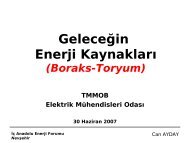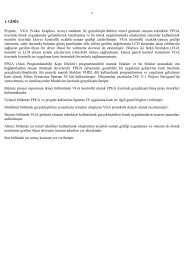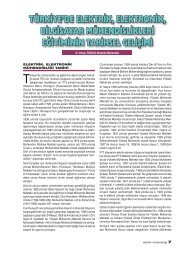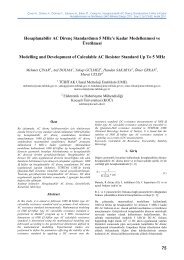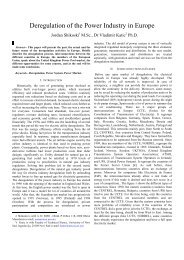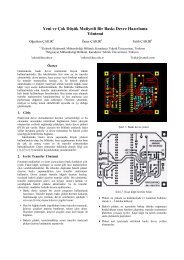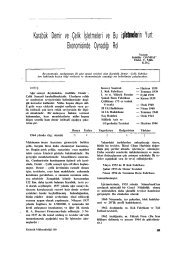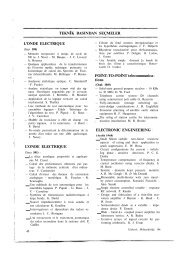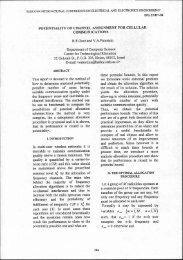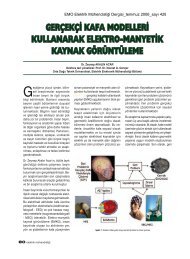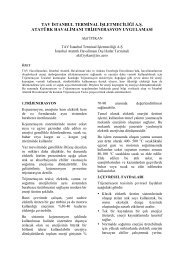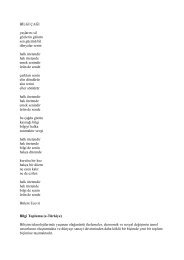Create successful ePaper yourself
Turn your PDF publications into a flip-book with our unique Google optimized e-Paper software.
MINIMIZATION OF JAMMING EFFECTS FOR PLANAR ARRAY<br />
ANTENNAS BY USING ADAPTIVE SIDE LOBE REDUCTION METHOD<br />
IN SPACE DOMAIN<br />
1 Necmi Serkan Tezel 2 Serkan Simsek<br />
e-mail:necmi@ehb.itu.edu.tr e-mail: ssimsek@istanbul.edu.tr<br />
1 Istanbul Technical University, Electric and Electronic Faculty , Electronics and Communication Department, 80626,<br />
Maslak , Istanbul, Turkey<br />
2 Istanbul University, Faculty of Engineering, Department of Electrical & Electronics Engineering, 34850,<br />
Avcılar, Istanbul, Turkey<br />
Key words: Jamming Effects, Adaptive Planar Array Antennas.<br />
ABSTRACT<br />
In this study, ratio of gain of the planar array antenna<br />
into target direction to those of jamming direction are<br />
maximized by weighting signals which are received<br />
each antenna with different coefficients before<br />
integration. The set of these coefficients set is found by<br />
adaptive steepest descent method. In numerical<br />
results, this algorithm is applied for given scenario<br />
and good agreement is observed.<br />
I.INTRODUCTION<br />
In today’s technology, most of advanced radar systems<br />
use electronic beam steering planar array, such as USA<br />
national missile defence system project. Reduction of<br />
sidelobes in planar array antenna is very important topic.<br />
Because of fact that minimizing of jamming effects and<br />
using the power efficiently are depend on side lobe level.<br />
Several methods have been proposed for reduction of<br />
sidolobe of the planar array antenna. Tapering of received<br />
signals using different weighting functions is a method<br />
for this aim [1]. However this method is not adaptive for<br />
given jamming direction and causes mainlobe beamwidth<br />
enlarging so angular resolution of radar decrease [1].<br />
An adaptive array steers its beam towards a desired signal<br />
while simultaneously steering a null towards an undesired,<br />
interfering signal and thereby maximizing the signal-tonoise<br />
ratio of the desired signal [2]. Adaptive nulling is<br />
considered to be the principal benefit of the adaptive<br />
techniques employed by adaptive array systems [3].<br />
Firstly, an adaptive interference nulling was recognized<br />
by Howells [4], [5]. Subsequently, a control law which<br />
maximizes signal to noise ratio (SNR) was improved by<br />
Applebaum [6]. Self-traning or self-optimizing control<br />
was applied to adaptive arrays by Widrow and others<br />
[7-9]. The self optimizing control was established on the<br />
least mean square error (LMS) algorithm that was based<br />
on the steepest descent.<br />
Modern military forces depend heavily on<br />
electromagnetic systems for surveillance, weapon control<br />
communication and navigation. Electronic<br />
countermeasures (ECM) are used by hostile forces to<br />
degrade the effectiveness of electromagnetic system. As a<br />
result of using ECM, ECCM (Electronic counter<br />
countermeasures) are used in radar systems for ECM<br />
threat [10]. ECM includes jamming which is intentionally<br />
and deliberately signals for the purpose of interfering and<br />
disturbing radar signals.<br />
Due to signal that come from radar is inversely<br />
proportional with r 4 , it is a weak signal. r is the distance<br />
of target. In order to amplify radar signal, receiver<br />
antenna has great gain. A receiver diagram of a radar<br />
antenna is depicted in Fig. 1. Jamming signal is very<br />
strong according to the signal that come from the target.<br />
The amplitude of poynting vector of expected signal from<br />
the target is , antenna gain at the main lobe isG .<br />
Pt t<br />
Poynting vector of jamming signal is P and antenna<br />
gain at the direction of jamming is G .<br />
P > G<br />
(2)<br />
t<br />
so<br />
j<br />
j<br />
j
P jG<br />
j >> Pt<br />
Gt<br />
(3) For r >> λ and r >> A11A1<br />
N , A11AMM<br />
, radiation field of<br />
A at P ( r,<br />
θ , φ ) can be expressed as<br />
( θ ,φ )<br />
j<br />
j<br />
Direction of<br />
jamming<br />
signal<br />
Direction of echo<br />
from the target<br />
Side<br />
lobes<br />
Main<br />
lobe<br />
( θ )<br />
t ,φt<br />
r<br />
E<br />
11<br />
− jkr<br />
r e<br />
11 = u11i11<br />
f ( θ , φ )<br />
r<br />
r<br />
where u11 is unit vector in the direction of E11 r<br />
feeding current of A . The radiation fields of<br />
A12 , A13<br />
, K,<br />
A1N<br />
r<br />
E<br />
r<br />
E<br />
r<br />
E<br />
12<br />
13<br />
1N<br />
≅ u<br />
r<br />
≅ u<br />
r<br />
≅ u<br />
r<br />
i<br />
11 12<br />
i<br />
11 13<br />
i<br />
11 1N<br />
e<br />
e<br />
− jkr12 r<br />
− jkr13 e<br />
r<br />
r<br />
11<br />
can be expressed as<br />
− jkr1<br />
N<br />
f ( θ , φ )<br />
f ( θ , φ )<br />
f ( θ , φ )<br />
(4)<br />
and i is<br />
Total electric field for linear antennas in the x-direction<br />
P r,<br />
θ , φ is given as below<br />
for ( )<br />
totalx<br />
Figure 1. Receiver diagram of a radar antenna where<br />
Jamming signal effects expected and returned signal from<br />
( θ , ) I DX<br />
the target. In order to cope with this problem: E ( θ , φ ) u f ( θ , φ )<br />
11<br />
(5)<br />
(7)<br />
(8)<br />
r r<br />
E = E φ<br />
(9)<br />
i) The directions of jamming signals have to be<br />
r r<br />
r r<br />
jkd2<br />
ur<br />
. ud<br />
jkd Nur<br />
. ud<br />
determined. I [ i + i e + ... + i e ]<br />
ii) Amplitudes of radiations have to reduce to zero.<br />
iii) When the radiation diagram is partially changed the<br />
direction of main lobe shouldn’t be replaced.<br />
Adaptive array antennas are used for these processes.<br />
II. FORMULATION OF THE PROBLEM<br />
A planar array antennas which consist A11 , A12<br />
, K A<br />
antennas is illustrated in Figure 2.<br />
y<br />
iM1,AM1 x<br />
i31,A31 x<br />
i21,A21 x<br />
x<br />
A11<br />
i11<br />
x AM2,iM2<br />
x A32,i32<br />
x A22,i22<br />
...<br />
...<br />
...<br />
z<br />
Figure 2. Planar array antennas.<br />
x<br />
A12<br />
i12<br />
x AMN,iMN<br />
x A3N,i3N<br />
x A2N,i2N<br />
x<br />
A1N<br />
i1N<br />
x<br />
NM<br />
r<br />
0<br />
DX<br />
0<br />
r<br />
= 11<br />
11<br />
12<br />
− jkr<br />
e<br />
r<br />
1N<br />
(10)<br />
= (11)<br />
I DX is array factor in the x direction and d 2 ,... d N are<br />
distances of antennas along x direction to origin Let’s<br />
v r<br />
assume ud<br />
= u x and d 2 = d x d3 = 2d<br />
x d N = ( N −1)<br />
d x<br />
then (11) reduces to<br />
I<br />
DX<br />
=<br />
N<br />
∑ i1n<br />
n=<br />
1<br />
e<br />
jk<br />
( n−1)<br />
d x sinθ<br />
cosφ<br />
(12)<br />
Similarly when linear antennas are considered in the ydirection<br />
for P ( r,<br />
θ , φ ) , array factor in the y direction is<br />
given as below<br />
I<br />
DY<br />
=<br />
M<br />
∑ im1<br />
n=<br />
1<br />
e<br />
jk<br />
( m−1)<br />
d y sinθ<br />
sinφ<br />
(12)<br />
In this condition total array factor ( I DT ) and electric field<br />
is obtained for planar array as<br />
I = I I<br />
(13)<br />
DT<br />
DX<br />
DY
I<br />
DT<br />
=<br />
totalxy<br />
N<br />
M<br />
∑∑<br />
i<br />
nm<br />
n=<br />
1 m=<br />
1<br />
e<br />
jk<br />
( θ , ) I DT<br />
[ 1 sinθ<br />
sinφ<br />
]<br />
( n−<br />
) d sinθ<br />
cosφ<br />
+ ( m−1)<br />
d<br />
x<br />
y<br />
(14)<br />
r r<br />
E = E φ<br />
(15)<br />
0<br />
It is asumed that P t ( r,<br />
θ t , φt<br />
) is the target point and<br />
φ θ φ .<br />
feeding currents have phase ( )<br />
nm<br />
( θ ) ( ) ( ) t , φt<br />
= − jk n−1<br />
d sin θ cos φ − jk m−<br />
d sin θ sin φ (16)<br />
x t t<br />
y t t<br />
nm<br />
φ 1<br />
t ,<br />
t<br />
( θ ) ( ) ( ) j , φ j jk n−1<br />
d sin θ cos φ + jk m−<br />
d sin θ sin φ<br />
x j j<br />
y j j<br />
φ 1<br />
nm<br />
= (23)<br />
The feeding currents are optimized in order to obtain<br />
maximum ratio value. So optimized ratio (OR) is defined<br />
in terms of dB as<br />
I DT(<br />
θt<br />
, φt<br />
)<br />
OR = 20log10<br />
(24)<br />
I<br />
DT(<br />
θ j , φ j )<br />
In this case, total array factor ( I DT )<br />
All of<br />
III. NUMERICAL RESULTS<br />
the numerical results are obtained for<br />
N M<br />
I DT(<br />
θ , ) = ∑∑i<br />
t φt<br />
nm<br />
n=<br />
1 m=<br />
1<br />
(17)<br />
λ<br />
d x = d y = , N = M = 10 f = 100MHz<br />
. Initial value<br />
2<br />
of feeding current I = 1 A is chosen. In order to obtain<br />
is found. In this condition phase of every MxN antenna<br />
have to be adjusted for the main lobe direction which has<br />
85. Total electric field at the target point for planar array<br />
r<br />
r<br />
E ( t , φt<br />
) = E ( θ t , φt<br />
) I DT(<br />
θ , φ )<br />
(18)<br />
maximum value of (24) Adaptive Steepest Descent<br />
Algorithm is used. For different target and jamming<br />
angles ( θ t ,φt<br />
, θ j ,φ j ), optimized results are compared<br />
with general formula and is given in Table 1.<br />
θ 0<br />
total t t<br />
is found Similarly total electric field at the direction of<br />
jamming can be expressed as<br />
r<br />
r<br />
E ( θ j , φ j ) = E10<br />
( θ j , φ j ) I DT(<br />
θ , φ )<br />
(19)<br />
total j j<br />
It is desired that target-to-jamming ratio of antennas’<br />
gains have to reach maximum value. So desired ratio<br />
(DR) is defined in the below<br />
( θ , φ )<br />
G t t<br />
DR = max<br />
(20)<br />
G<br />
( θ , φ )<br />
j<br />
Gain of an antenna as defined as [10]<br />
j<br />
total<br />
2<br />
4πr 2<br />
ε / µ Erad<br />
G(<br />
θ , φ ) = (21)<br />
W<br />
So the ratio of radiated fields must be maximum. The<br />
distance of target is further than jamming. Moreover, the<br />
ratio of radiated fields depend on distance of target and<br />
jumming place. It is sufficient that the ratio of array<br />
factors of target-to-jamming must be maximum. This<br />
ratio is found as<br />
N<br />
M<br />
∑∑<br />
nm<br />
I DT(<br />
θt<br />
, φt<br />
)<br />
n=<br />
1 m=<br />
1<br />
=<br />
I<br />
N M<br />
DT(<br />
θ j , φ j )<br />
φnm<br />
j j<br />
∑∑inme<br />
n=<br />
1 m=<br />
1<br />
where<br />
i<br />
( θ , φ ) + φ ( θ , φ )<br />
nm<br />
t<br />
t<br />
(22)<br />
θ t<br />
20 o<br />
35 o<br />
50 o<br />
60 o<br />
75 o<br />
φ t<br />
45 o<br />
60 o<br />
75 o<br />
90 o<br />
120 o<br />
θ j<br />
φ j<br />
I=1 A<br />
OR<br />
30 o 120 o 43.6<br />
dB<br />
50 o 75 o 18.45<br />
dB<br />
85 o 100 o 37.79<br />
dB<br />
75 o 120 o 17.38<br />
dB<br />
90 o 180 o 42.6<br />
dB<br />
ASDA<br />
I=1 A<br />
(initial<br />
value)<br />
OR<br />
341.8<br />
dB<br />
338<br />
dB<br />
346.5<br />
dB<br />
332<br />
dB<br />
93.19<br />
dB<br />
Table 1. Comparison of optimization ratios.<br />
Reco<br />
very<br />
298.2<br />
dB<br />
319.55<br />
dB<br />
308.71<br />
dB<br />
314.62<br />
dB<br />
50.59<br />
dB<br />
4. CONCLUSIONS<br />
In Table 1, optimized values of target-to-jamming ratio of<br />
array factors are tabulated for different target and<br />
jamming angles. A considerable improvement of targetto-jamming<br />
ratio of array factors is achieved.<br />
5. REFERENCES<br />
1. Tezel N. S. ‘ Comparison of beams that are obtained<br />
by using different weighting functions for planar<br />
array antennas ’ , URSI 2002, Istanbul.<br />
2. Kraus J. D., Marhefka R. J., ‘Antennas for All<br />
Applications’, McGraw Hill Companies, Inc., 3 rd ed. ,<br />
2002.<br />
3. Monzingo R.A., Miller T. W., ‘Introduction to<br />
Adaptive Arrays’, John Wiley & Sons, Newyork.<br />
4. Howells P. W., ‘Intermediate Frequency Sidelobe<br />
Canceller’ ,U.S. Patent 3203990, August 24, 1965.
5. Howells P. W., ‘Expolarions in Fixed and Adaptive<br />
Resolution at Geand SURC’, IEE Trans. Antennas<br />
Propag., Special Issue on Adaptive Antennas, Vol.<br />
AP-24, No 5, September, 1976.<br />
6. Applebaum S. P., ‘Adaptive Arrays’ Syracuse<br />
University Research Corporation, R. SPL TR66-1,<br />
August 1966.<br />
7. Widrow. B., ‘Adaptive Filters I: Fundamentals’,<br />
Stanford University Electronics Laboratories, System<br />
Theory Laboratory, Center for Systems Research,<br />
Rep. SU-SEL-66-12, Tech. R. 6764-6, December<br />
1966.<br />
8. Widrow. B., ‘Adaptive Filters’, in Asa-pects of<br />
Network and System Theory, New York, 1971.<br />
9. Widrow. B., Mantey P. E., Griffiths L. J., and Goode<br />
B. B., ‘Adaptive Antenna System’, Proc. IEEE,<br />
Vol.55, December 1967.<br />
10. Skolnik M.,’Radar Handbook’, McGraw-Hill, Inc.,<br />
Singapoure, 1991.<br />
11. Akkaya I., ‘Antennas and Propagation ’, System Inc.,<br />
Istanbul, March 1997.



